Small and Medium Enterprises (SMEs) Assignment: MGT-308, RU
VerifiedAdded on 2022/01/19
|70
|15231
|49
Homework Assignment
AI Summary
This assignment delves into the realm of Small and Medium Enterprises (SMEs), crucial for economic development, especially in developing nations like Bangladesh. It begins with a preface highlighting the significance of SMEs in employment generation, poverty reduction, and economic growth, emphasizing their role in achieving Millennium Development Goals. The assignment defines SMEs, exploring how their classification varies across countries based on factors like employee count, annual sales, and assets. It presents the SME definitions in Bangladesh, as per the Ministry of Industry and Bangladesh Bank, including criteria for small, medium, and micro-enterprises in service, business, and industry sectors, also considering women entrepreneurs. Furthermore, the assignment provides comparative definitions from the USA, EU, UK, Kenya, China, Egypt, and India, showcasing the diverse approaches to SME classification globally. It underscores the importance of SMEs, their contribution to GDP, and their impact on innovation and diversity. The assignment aims to provide a comprehensive understanding of SMEs, their characteristics, and their role in socio-economic development, making it a valuable resource for students studying entrepreneurship and SME management.
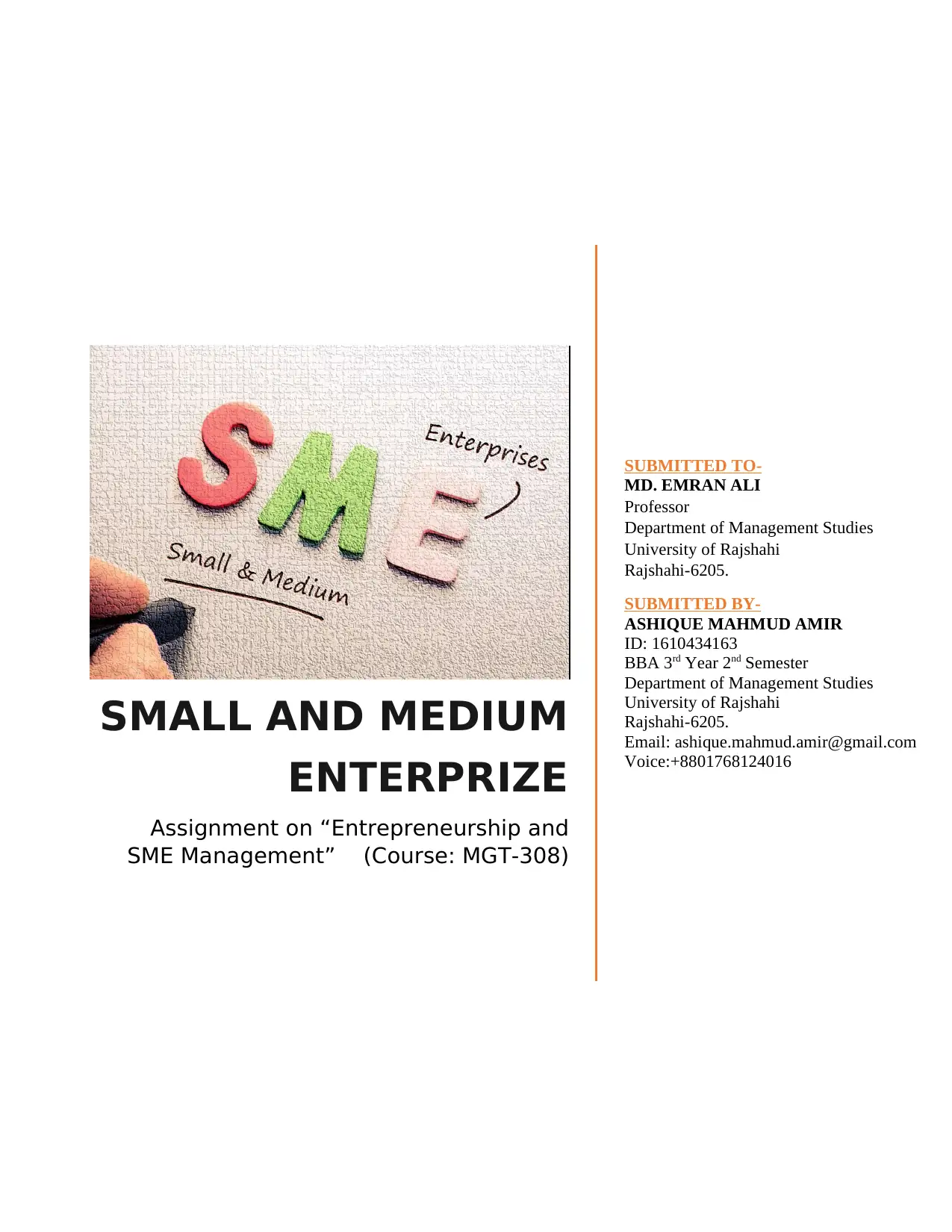
Small and Medium Enterprises (SMEs)
An Assignment
1 | Ashique Mahmud Amir
BBA 3rd Year 2nd Semester
Dept. of Management Studies, RU.
SMALL AND MEDIUM
ENTERPRIZE
Assignment on “Entrepreneurship and
SME Management” (Course: MGT-308)
SUBMITTED TO-
MD. EMRAN ALI
Professor
Department of Management Studies
University of Rajshahi
Rajshahi-6205.
SUBMITTED BY-
ASHIQUE MAHMUD AMIR
ID: 1610434163
BBA 3rd Year 2nd Semester
Department of Management Studies
University of Rajshahi
Rajshahi-6205.
Email: ashique.mahmud.amir@gmail.com
Voice:+8801768124016
An Assignment
1 | Ashique Mahmud Amir
BBA 3rd Year 2nd Semester
Dept. of Management Studies, RU.
SMALL AND MEDIUM
ENTERPRIZE
Assignment on “Entrepreneurship and
SME Management” (Course: MGT-308)
SUBMITTED TO-
MD. EMRAN ALI
Professor
Department of Management Studies
University of Rajshahi
Rajshahi-6205.
SUBMITTED BY-
ASHIQUE MAHMUD AMIR
ID: 1610434163
BBA 3rd Year 2nd Semester
Department of Management Studies
University of Rajshahi
Rajshahi-6205.
Email: ashique.mahmud.amir@gmail.com
Voice:+8801768124016
Paraphrase This Document
Need a fresh take? Get an instant paraphrase of this document with our AI Paraphraser
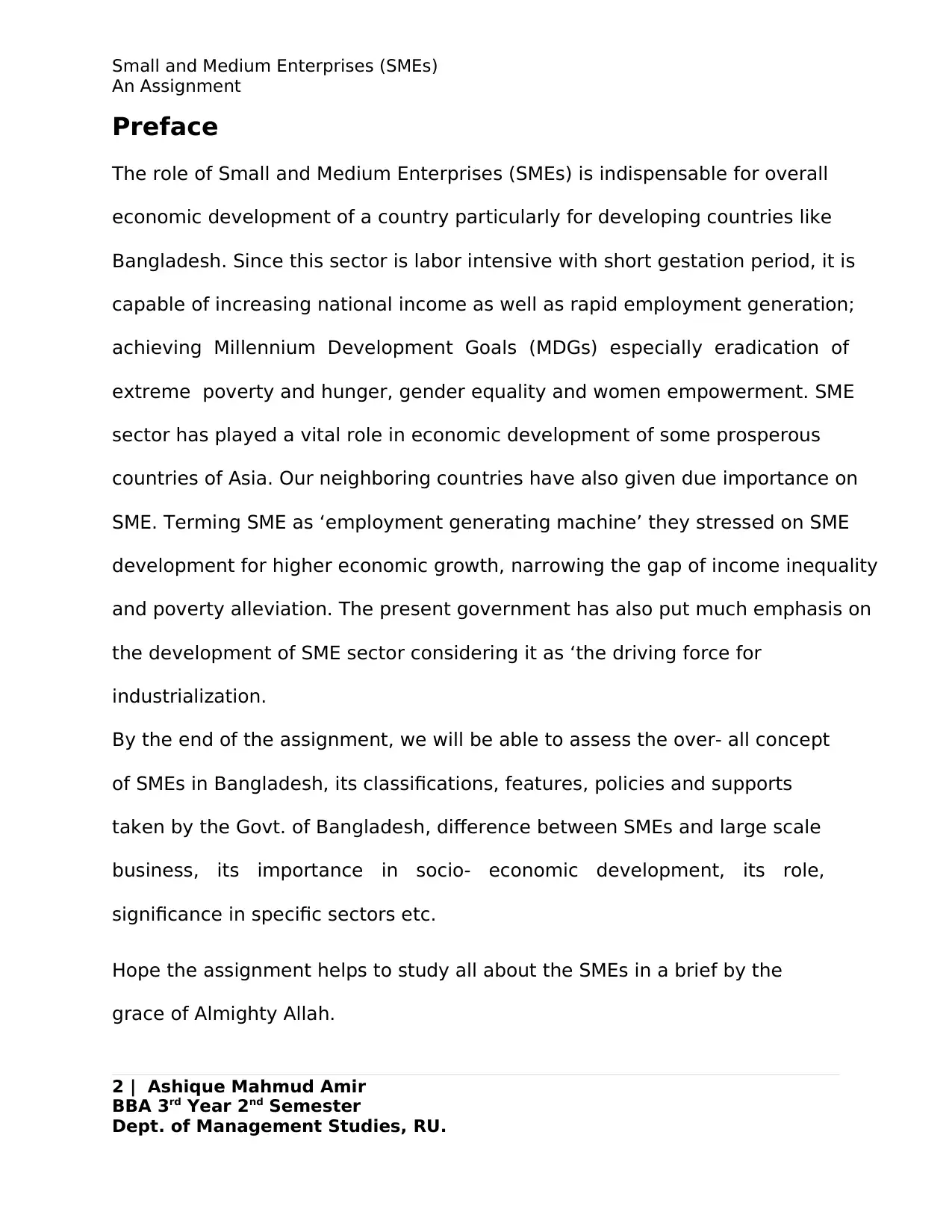
Small and Medium Enterprises (SMEs)
An Assignment
Preface
The role of Small and Medium Enterprises (SMEs) is indispensable for overall
economic development of a country particularly for developing countries like
Bangladesh. Since this sector is labor intensive with short gestation period, it is
capable of increasing national income as well as rapid employment generation;
achieving Millennium Development Goals (MDGs) especially eradication of
extreme poverty and hunger, gender equality and women empowerment. SME
sector has played a vital role in economic development of some prosperous
countries of Asia. Our neighboring countries have also given due importance on
SME. Terming SME as ‘employment generating machine’ they stressed on SME
development for higher economic growth, narrowing the gap of income inequality
and poverty alleviation. The present government has also put much emphasis on
the development of SME sector considering it as ‘the driving force for
industrialization.
By the end of the assignment, we will be able to assess the over- all concept
of SMEs in Bangladesh, its classifications, features, policies and supports
taken by the Govt. of Bangladesh, difference between SMEs and large scale
business, its importance in socio- economic development, its role,
significance in specific sectors etc.
Hope the assignment helps to study all about the SMEs in a brief by the
grace of Almighty Allah.
2 | Ashique Mahmud Amir
BBA 3rd Year 2nd Semester
Dept. of Management Studies, RU.
An Assignment
Preface
The role of Small and Medium Enterprises (SMEs) is indispensable for overall
economic development of a country particularly for developing countries like
Bangladesh. Since this sector is labor intensive with short gestation period, it is
capable of increasing national income as well as rapid employment generation;
achieving Millennium Development Goals (MDGs) especially eradication of
extreme poverty and hunger, gender equality and women empowerment. SME
sector has played a vital role in economic development of some prosperous
countries of Asia. Our neighboring countries have also given due importance on
SME. Terming SME as ‘employment generating machine’ they stressed on SME
development for higher economic growth, narrowing the gap of income inequality
and poverty alleviation. The present government has also put much emphasis on
the development of SME sector considering it as ‘the driving force for
industrialization.
By the end of the assignment, we will be able to assess the over- all concept
of SMEs in Bangladesh, its classifications, features, policies and supports
taken by the Govt. of Bangladesh, difference between SMEs and large scale
business, its importance in socio- economic development, its role,
significance in specific sectors etc.
Hope the assignment helps to study all about the SMEs in a brief by the
grace of Almighty Allah.
2 | Ashique Mahmud Amir
BBA 3rd Year 2nd Semester
Dept. of Management Studies, RU.
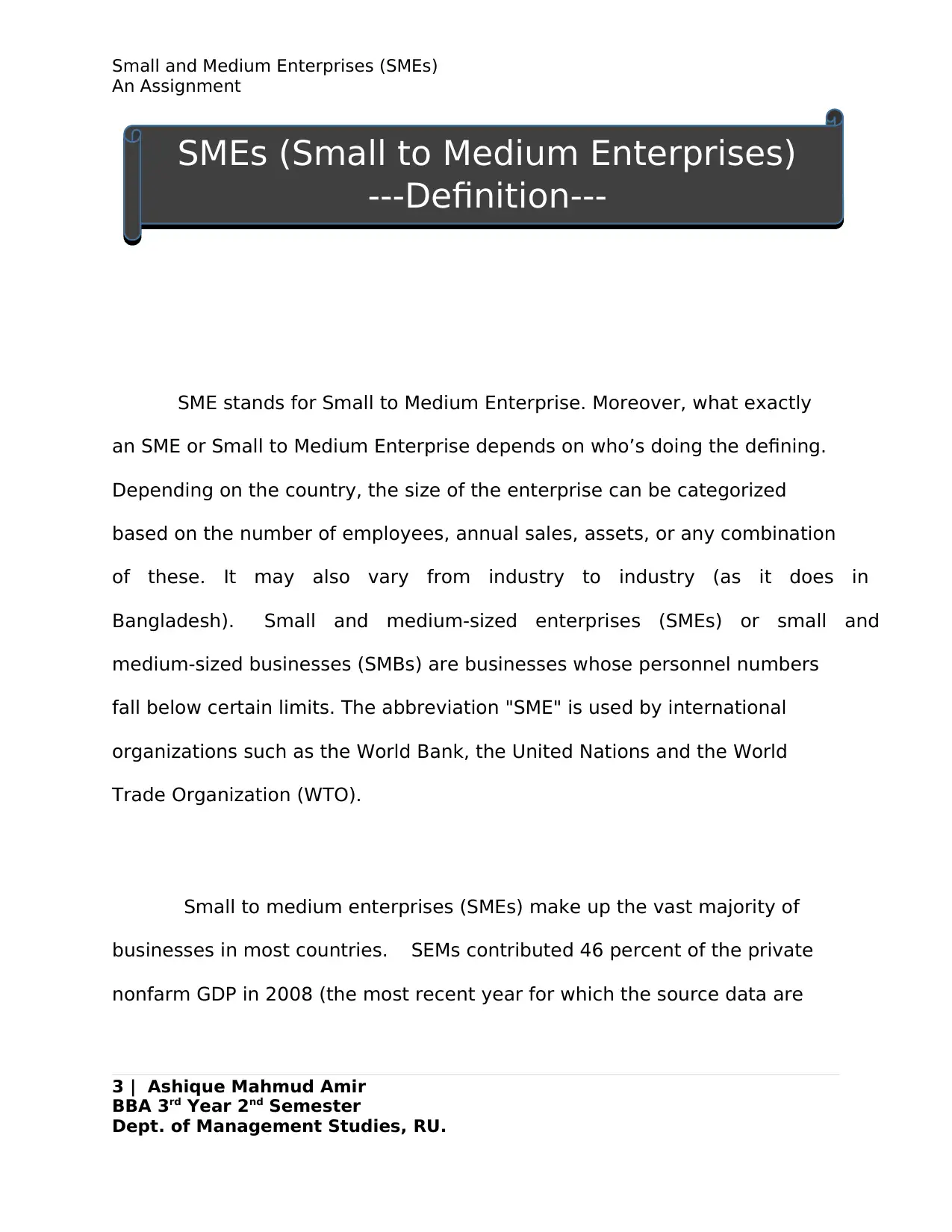
Small and Medium Enterprises (SMEs)
An Assignment
SME stands for Small to Medium Enterprise. Moreover, what exactly
an SME or Small to Medium Enterprise depends on who’s doing the defining.
Depending on the country, the size of the enterprise can be categorized
based on the number of employees, annual sales, assets, or any combination
of these. It may also vary from industry to industry (as it does in
Bangladesh). Small and medium-sized enterprises (SMEs) or small and
medium-sized businesses (SMBs) are businesses whose personnel numbers
fall below certain limits. The abbreviation "SME" is used by international
organizations such as the World Bank, the United Nations and the World
Trade Organization (WTO).
Small to medium enterprises (SMEs) make up the vast majority of
businesses in most countries. SEMs contributed 46 percent of the private
nonfarm GDP in 2008 (the most recent year for which the source data are
3 | Ashique Mahmud Amir
BBA 3rd Year 2nd Semester
Dept. of Management Studies, RU.
SMEs (Small to Medium Enterprises)
---Definition---
An Assignment
SME stands for Small to Medium Enterprise. Moreover, what exactly
an SME or Small to Medium Enterprise depends on who’s doing the defining.
Depending on the country, the size of the enterprise can be categorized
based on the number of employees, annual sales, assets, or any combination
of these. It may also vary from industry to industry (as it does in
Bangladesh). Small and medium-sized enterprises (SMEs) or small and
medium-sized businesses (SMBs) are businesses whose personnel numbers
fall below certain limits. The abbreviation "SME" is used by international
organizations such as the World Bank, the United Nations and the World
Trade Organization (WTO).
Small to medium enterprises (SMEs) make up the vast majority of
businesses in most countries. SEMs contributed 46 percent of the private
nonfarm GDP in 2008 (the most recent year for which the source data are
3 | Ashique Mahmud Amir
BBA 3rd Year 2nd Semester
Dept. of Management Studies, RU.
SMEs (Small to Medium Enterprises)
---Definition---
⊘ This is a preview!⊘
Do you want full access?
Subscribe today to unlock all pages.

Trusted by 1+ million students worldwide
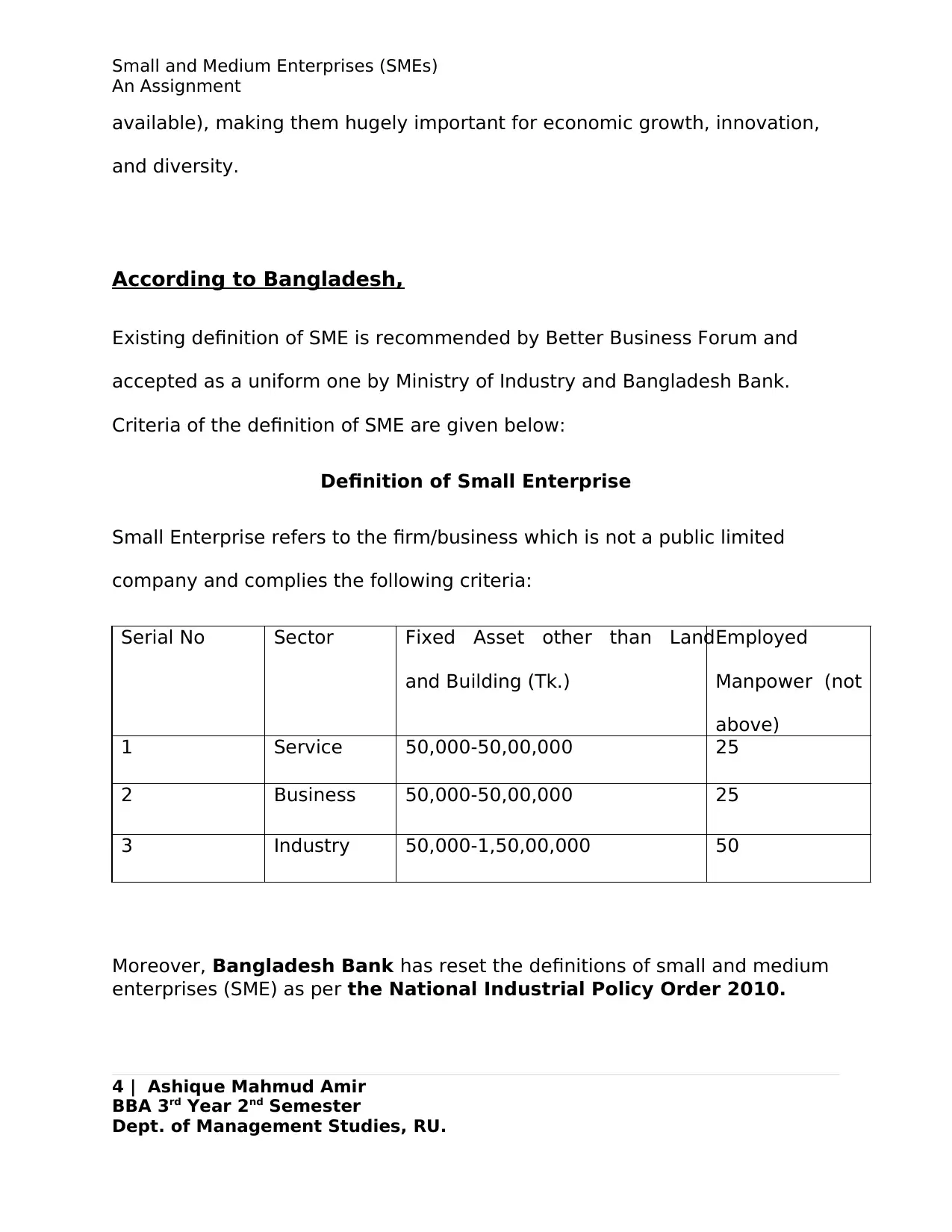
Small and Medium Enterprises (SMEs)
An Assignment
available), making them hugely important for economic growth, innovation,
and diversity.
According to Bangladesh,
Existing definition of SME is recommended by Better Business Forum and
accepted as a uniform one by Ministry of Industry and Bangladesh Bank.
Criteria of the definition of SME are given below:
Definition of Small Enterprise
Small Enterprise refers to the firm/business which is not a public limited
company and complies the following criteria:
Serial No Sector Fixed Asset other than Land
and Building (Tk.)
Employed
Manpower (not
above)
1 Service 50,000-50,00,000 25
2 Business 50,000-50,00,000 25
3 Industry 50,000-1,50,00,000 50
Moreover, Bangladesh Bank has reset the definitions of small and medium
enterprises (SME) as per the National Industrial Policy Order 2010.
4 | Ashique Mahmud Amir
BBA 3rd Year 2nd Semester
Dept. of Management Studies, RU.
An Assignment
available), making them hugely important for economic growth, innovation,
and diversity.
According to Bangladesh,
Existing definition of SME is recommended by Better Business Forum and
accepted as a uniform one by Ministry of Industry and Bangladesh Bank.
Criteria of the definition of SME are given below:
Definition of Small Enterprise
Small Enterprise refers to the firm/business which is not a public limited
company and complies the following criteria:
Serial No Sector Fixed Asset other than Land
and Building (Tk.)
Employed
Manpower (not
above)
1 Service 50,000-50,00,000 25
2 Business 50,000-50,00,000 25
3 Industry 50,000-1,50,00,000 50
Moreover, Bangladesh Bank has reset the definitions of small and medium
enterprises (SME) as per the National Industrial Policy Order 2010.
4 | Ashique Mahmud Amir
BBA 3rd Year 2nd Semester
Dept. of Management Studies, RU.
Paraphrase This Document
Need a fresh take? Get an instant paraphrase of this document with our AI Paraphraser
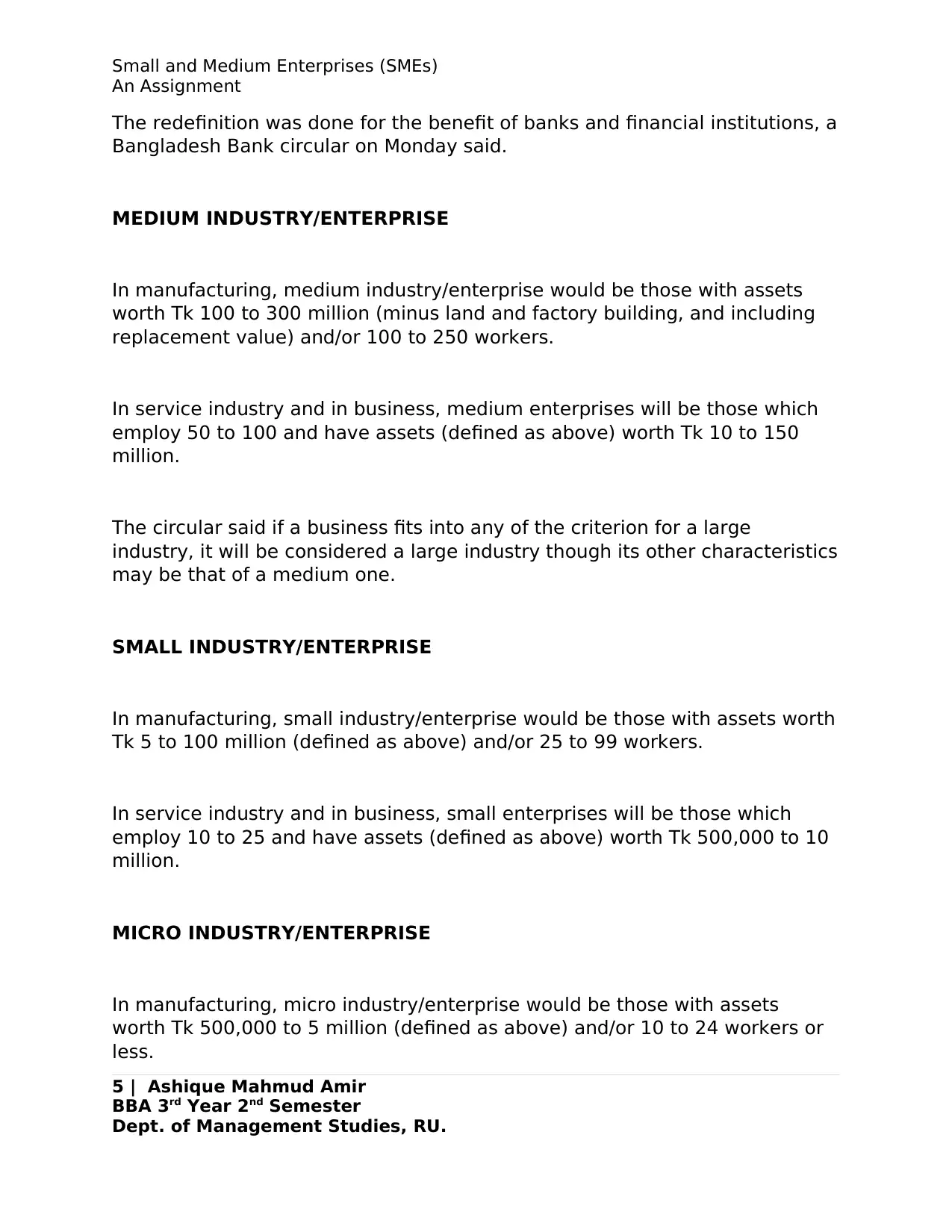
Small and Medium Enterprises (SMEs)
An Assignment
The redefinition was done for the benefit of banks and financial institutions, a
Bangladesh Bank circular on Monday said.
MEDIUM INDUSTRY/ENTERPRISE
In manufacturing, medium industry/enterprise would be those with assets
worth Tk 100 to 300 million (minus land and factory building, and including
replacement value) and/or 100 to 250 workers.
In service industry and in business, medium enterprises will be those which
employ 50 to 100 and have assets (defined as above) worth Tk 10 to 150
million.
The circular said if a business fits into any of the criterion for a large
industry, it will be considered a large industry though its other characteristics
may be that of a medium one.
SMALL INDUSTRY/ENTERPRISE
In manufacturing, small industry/enterprise would be those with assets worth
Tk 5 to 100 million (defined as above) and/or 25 to 99 workers.
In service industry and in business, small enterprises will be those which
employ 10 to 25 and have assets (defined as above) worth Tk 500,000 to 10
million.
MICRO INDUSTRY/ENTERPRISE
In manufacturing, micro industry/enterprise would be those with assets
worth Tk 500,000 to 5 million (defined as above) and/or 10 to 24 workers or
less.
5 | Ashique Mahmud Amir
BBA 3rd Year 2nd Semester
Dept. of Management Studies, RU.
An Assignment
The redefinition was done for the benefit of banks and financial institutions, a
Bangladesh Bank circular on Monday said.
MEDIUM INDUSTRY/ENTERPRISE
In manufacturing, medium industry/enterprise would be those with assets
worth Tk 100 to 300 million (minus land and factory building, and including
replacement value) and/or 100 to 250 workers.
In service industry and in business, medium enterprises will be those which
employ 50 to 100 and have assets (defined as above) worth Tk 10 to 150
million.
The circular said if a business fits into any of the criterion for a large
industry, it will be considered a large industry though its other characteristics
may be that of a medium one.
SMALL INDUSTRY/ENTERPRISE
In manufacturing, small industry/enterprise would be those with assets worth
Tk 5 to 100 million (defined as above) and/or 25 to 99 workers.
In service industry and in business, small enterprises will be those which
employ 10 to 25 and have assets (defined as above) worth Tk 500,000 to 10
million.
MICRO INDUSTRY/ENTERPRISE
In manufacturing, micro industry/enterprise would be those with assets
worth Tk 500,000 to 5 million (defined as above) and/or 10 to 24 workers or
less.
5 | Ashique Mahmud Amir
BBA 3rd Year 2nd Semester
Dept. of Management Studies, RU.
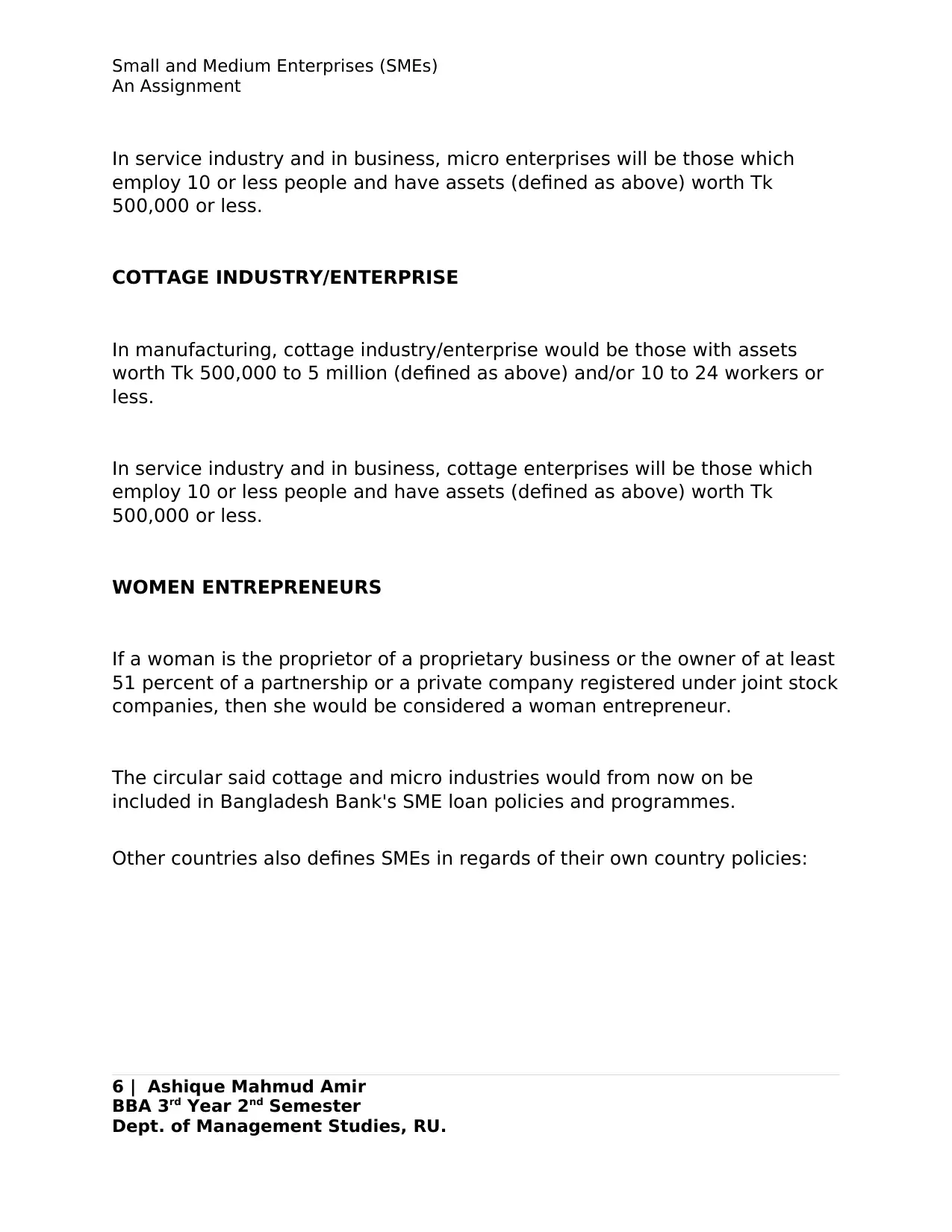
Small and Medium Enterprises (SMEs)
An Assignment
In service industry and in business, micro enterprises will be those which
employ 10 or less people and have assets (defined as above) worth Tk
500,000 or less.
COTTAGE INDUSTRY/ENTERPRISE
In manufacturing, cottage industry/enterprise would be those with assets
worth Tk 500,000 to 5 million (defined as above) and/or 10 to 24 workers or
less.
In service industry and in business, cottage enterprises will be those which
employ 10 or less people and have assets (defined as above) worth Tk
500,000 or less.
WOMEN ENTREPRENEURS
If a woman is the proprietor of a proprietary business or the owner of at least
51 percent of a partnership or a private company registered under joint stock
companies, then she would be considered a woman entrepreneur.
The circular said cottage and micro industries would from now on be
included in Bangladesh Bank's SME loan policies and programmes.
Other countries also defines SMEs in regards of their own country policies:
6 | Ashique Mahmud Amir
BBA 3rd Year 2nd Semester
Dept. of Management Studies, RU.
An Assignment
In service industry and in business, micro enterprises will be those which
employ 10 or less people and have assets (defined as above) worth Tk
500,000 or less.
COTTAGE INDUSTRY/ENTERPRISE
In manufacturing, cottage industry/enterprise would be those with assets
worth Tk 500,000 to 5 million (defined as above) and/or 10 to 24 workers or
less.
In service industry and in business, cottage enterprises will be those which
employ 10 or less people and have assets (defined as above) worth Tk
500,000 or less.
WOMEN ENTREPRENEURS
If a woman is the proprietor of a proprietary business or the owner of at least
51 percent of a partnership or a private company registered under joint stock
companies, then she would be considered a woman entrepreneur.
The circular said cottage and micro industries would from now on be
included in Bangladesh Bank's SME loan policies and programmes.
Other countries also defines SMEs in regards of their own country policies:
6 | Ashique Mahmud Amir
BBA 3rd Year 2nd Semester
Dept. of Management Studies, RU.
⊘ This is a preview!⊘
Do you want full access?
Subscribe today to unlock all pages.

Trusted by 1+ million students worldwide
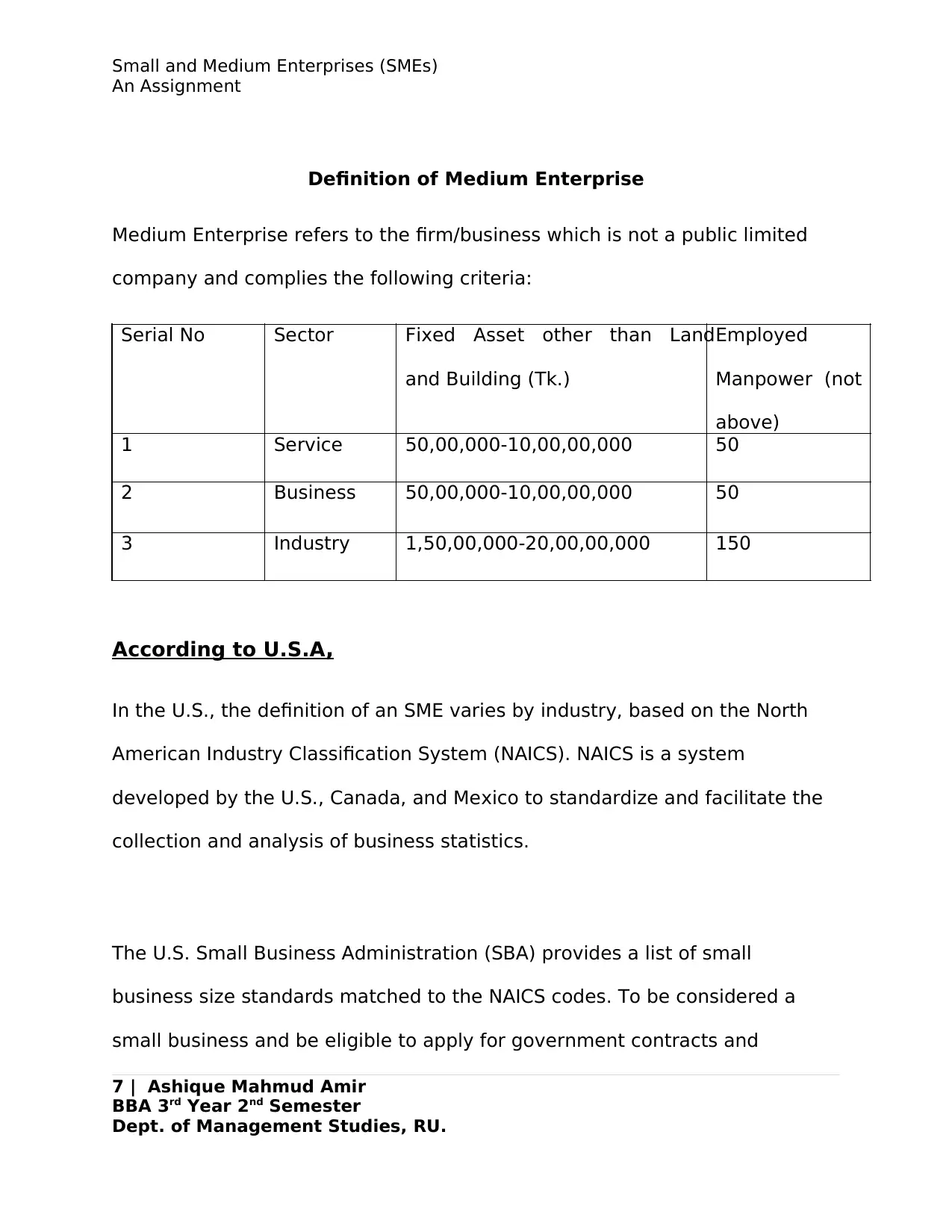
Small and Medium Enterprises (SMEs)
An Assignment
Definition of Medium Enterprise
Medium Enterprise refers to the firm/business which is not a public limited
company and complies the following criteria:
Serial No Sector Fixed Asset other than Land
and Building (Tk.)
Employed
Manpower (not
above)
1 Service 50,00,000-10,00,00,000 50
2 Business 50,00,000-10,00,00,000 50
3 Industry 1,50,00,000-20,00,00,000 150
According to U.S.A,
In the U.S., the definition of an SME varies by industry, based on the North
American Industry Classification System (NAICS). NAICS is a system
developed by the U.S., Canada, and Mexico to standardize and facilitate the
collection and analysis of business statistics.
The U.S. Small Business Administration (SBA) provides a list of small
business size standards matched to the NAICS codes. To be considered a
small business and be eligible to apply for government contracts and
7 | Ashique Mahmud Amir
BBA 3rd Year 2nd Semester
Dept. of Management Studies, RU.
An Assignment
Definition of Medium Enterprise
Medium Enterprise refers to the firm/business which is not a public limited
company and complies the following criteria:
Serial No Sector Fixed Asset other than Land
and Building (Tk.)
Employed
Manpower (not
above)
1 Service 50,00,000-10,00,00,000 50
2 Business 50,00,000-10,00,00,000 50
3 Industry 1,50,00,000-20,00,00,000 150
According to U.S.A,
In the U.S., the definition of an SME varies by industry, based on the North
American Industry Classification System (NAICS). NAICS is a system
developed by the U.S., Canada, and Mexico to standardize and facilitate the
collection and analysis of business statistics.
The U.S. Small Business Administration (SBA) provides a list of small
business size standards matched to the NAICS codes. To be considered a
small business and be eligible to apply for government contracts and
7 | Ashique Mahmud Amir
BBA 3rd Year 2nd Semester
Dept. of Management Studies, RU.
Paraphrase This Document
Need a fresh take? Get an instant paraphrase of this document with our AI Paraphraser
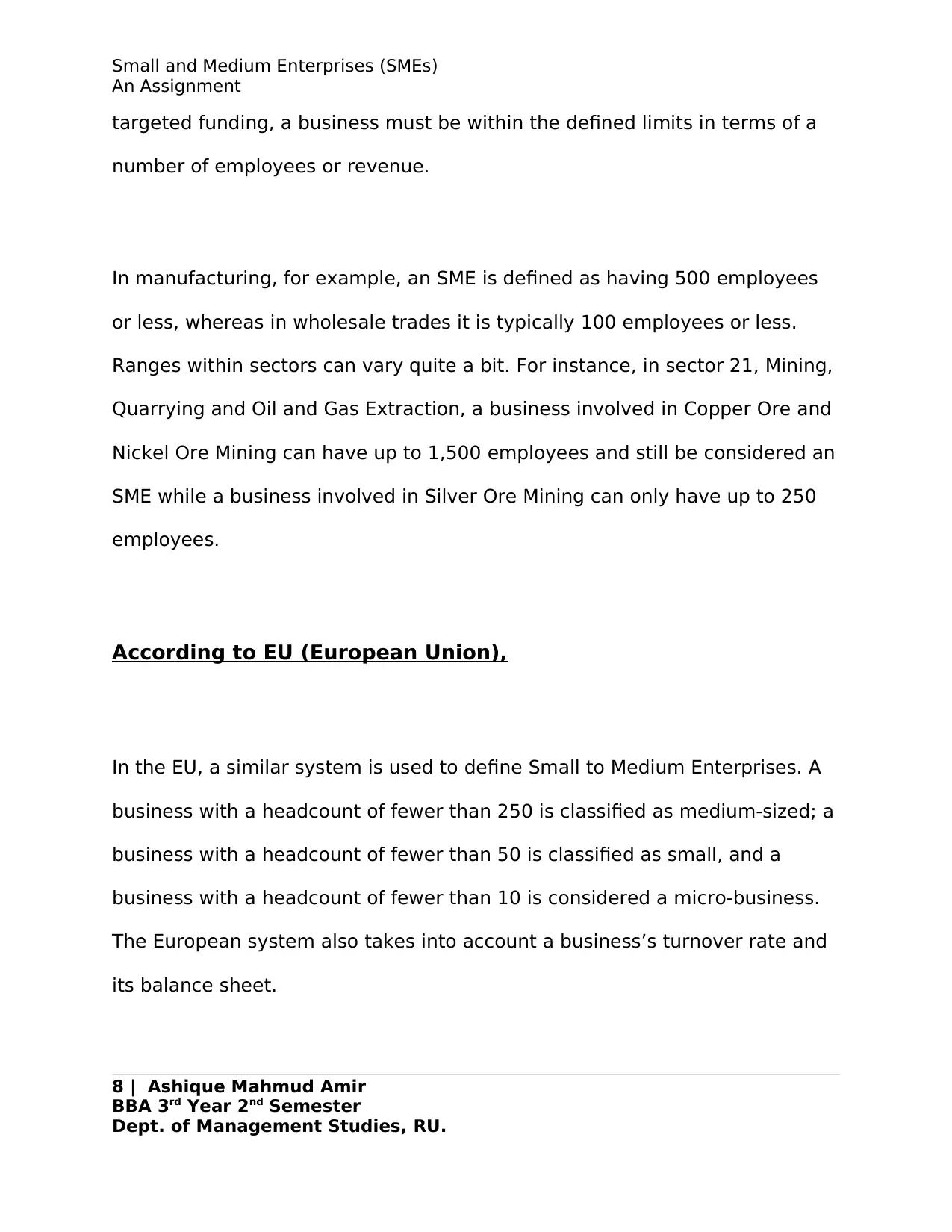
Small and Medium Enterprises (SMEs)
An Assignment
targeted funding, a business must be within the defined limits in terms of a
number of employees or revenue.
In manufacturing, for example, an SME is defined as having 500 employees
or less, whereas in wholesale trades it is typically 100 employees or less.
Ranges within sectors can vary quite a bit. For instance, in sector 21, Mining,
Quarrying and Oil and Gas Extraction, a business involved in Copper Ore and
Nickel Ore Mining can have up to 1,500 employees and still be considered an
SME while a business involved in Silver Ore Mining can only have up to 250
employees.
According to EU (European Union),
In the EU, a similar system is used to define Small to Medium Enterprises. A
business with a headcount of fewer than 250 is classified as medium-sized; a
business with a headcount of fewer than 50 is classified as small, and a
business with a headcount of fewer than 10 is considered a micro-business.
The European system also takes into account a business’s turnover rate and
its balance sheet.
8 | Ashique Mahmud Amir
BBA 3rd Year 2nd Semester
Dept. of Management Studies, RU.
An Assignment
targeted funding, a business must be within the defined limits in terms of a
number of employees or revenue.
In manufacturing, for example, an SME is defined as having 500 employees
or less, whereas in wholesale trades it is typically 100 employees or less.
Ranges within sectors can vary quite a bit. For instance, in sector 21, Mining,
Quarrying and Oil and Gas Extraction, a business involved in Copper Ore and
Nickel Ore Mining can have up to 1,500 employees and still be considered an
SME while a business involved in Silver Ore Mining can only have up to 250
employees.
According to EU (European Union),
In the EU, a similar system is used to define Small to Medium Enterprises. A
business with a headcount of fewer than 250 is classified as medium-sized; a
business with a headcount of fewer than 50 is classified as small, and a
business with a headcount of fewer than 10 is considered a micro-business.
The European system also takes into account a business’s turnover rate and
its balance sheet.
8 | Ashique Mahmud Amir
BBA 3rd Year 2nd Semester
Dept. of Management Studies, RU.
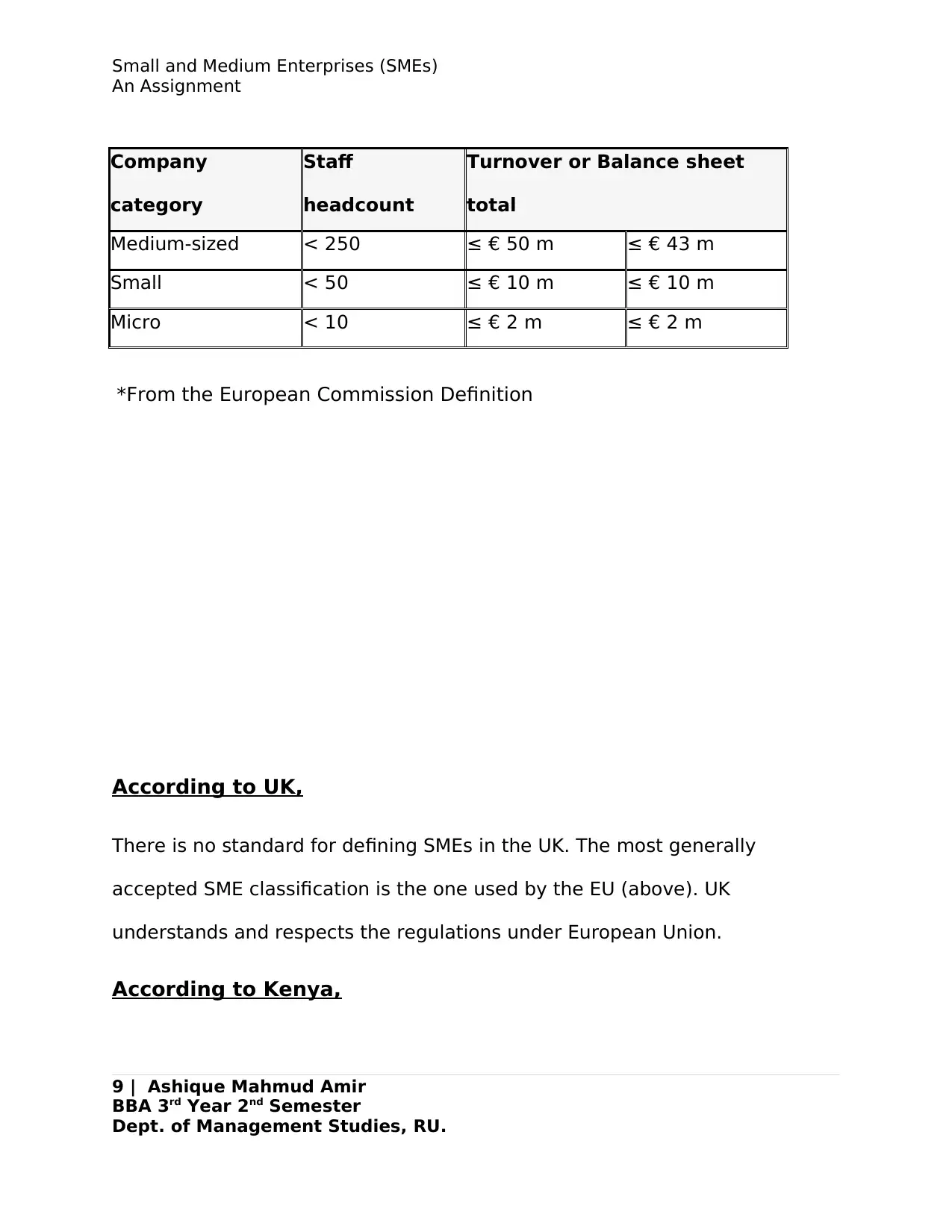
Small and Medium Enterprises (SMEs)
An Assignment
*From the European Commission Definition
According to UK,
There is no standard for defining SMEs in the UK. The most generally
accepted SME classification is the one used by the EU (above). UK
understands and respects the regulations under European Union.
According to Kenya,
9 | Ashique Mahmud Amir
BBA 3rd Year 2nd Semester
Dept. of Management Studies, RU.
Company
category
Staff
headcount
Turnover or Balance sheet
total
Medium-sized < 250 ≤ € 50 m ≤ € 43 m
Small < 50 ≤ € 10 m ≤ € 10 m
Micro < 10 ≤ € 2 m ≤ € 2 m
An Assignment
*From the European Commission Definition
According to UK,
There is no standard for defining SMEs in the UK. The most generally
accepted SME classification is the one used by the EU (above). UK
understands and respects the regulations under European Union.
According to Kenya,
9 | Ashique Mahmud Amir
BBA 3rd Year 2nd Semester
Dept. of Management Studies, RU.
Company
category
Staff
headcount
Turnover or Balance sheet
total
Medium-sized < 250 ≤ € 50 m ≤ € 43 m
Small < 50 ≤ € 10 m ≤ € 10 m
Micro < 10 ≤ € 2 m ≤ € 2 m
⊘ This is a preview!⊘
Do you want full access?
Subscribe today to unlock all pages.

Trusted by 1+ million students worldwide
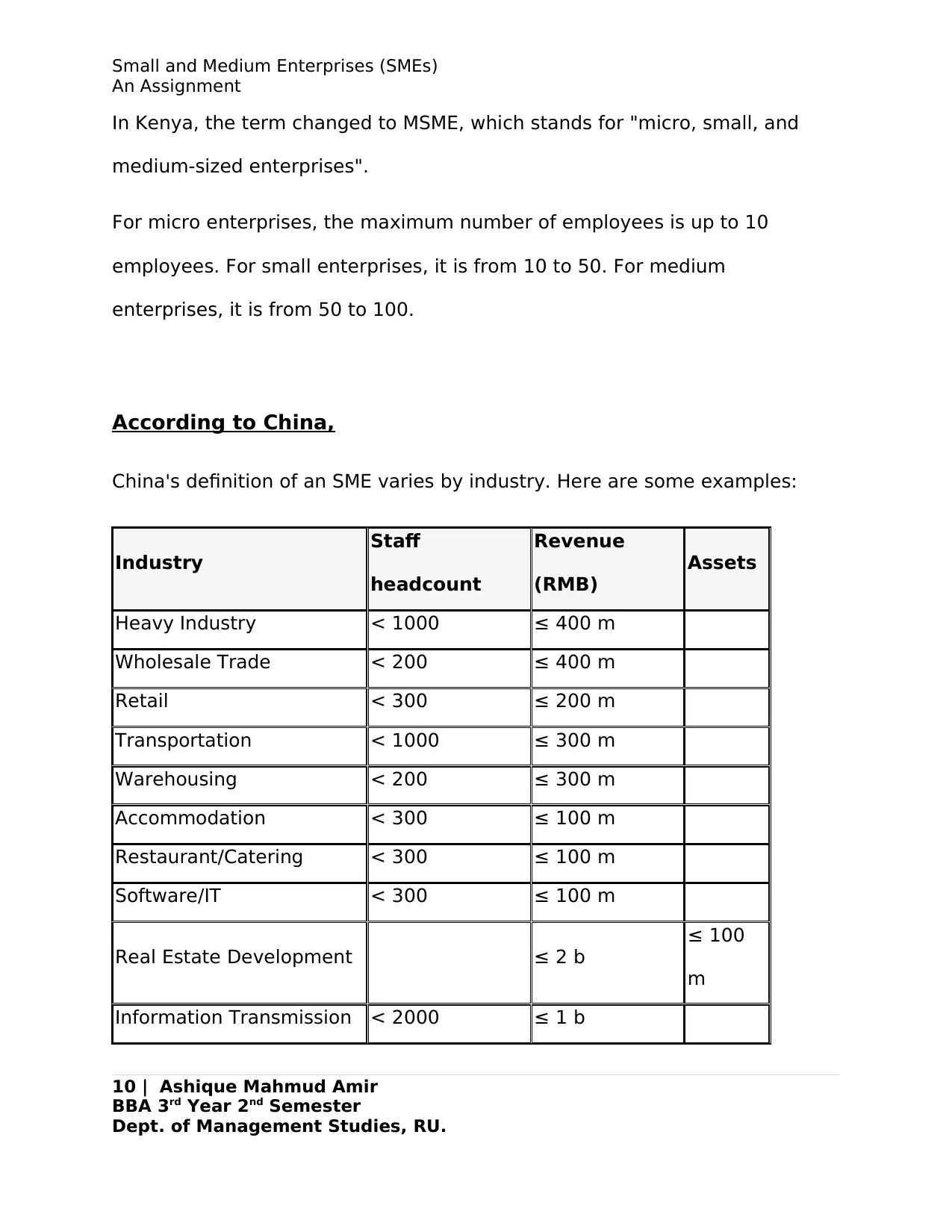
Small and Medium Enterprises (SMEs)
An Assignment
In Kenya, the term changed to MSME, which stands for "micro, small, and
medium-sized enterprises".
For micro enterprises, the maximum number of employees is up to 10
employees. For small enterprises, it is from 10 to 50. For medium
enterprises, it is from 50 to 100.
According to China,
China's definition of an SME varies by industry. Here are some examples:
Industry
Staff
headcount
Revenue
(RMB)
Assets
Heavy Industry < 1000 ≤ 400 m
Wholesale Trade < 200 ≤ 400 m
Retail < 300 ≤ 200 m
Transportation < 1000 ≤ 300 m
Warehousing < 200 ≤ 300 m
Accommodation < 300 ≤ 100 m
Restaurant/Catering < 300 ≤ 100 m
Software/IT < 300 ≤ 100 m
Real Estate Development ≤ 2 b
≤ 100
m
Information Transmission < 2000 ≤ 1 b
10 | Ashique Mahmud Amir
BBA 3rd Year 2nd Semester
Dept. of Management Studies, RU.
An Assignment
In Kenya, the term changed to MSME, which stands for "micro, small, and
medium-sized enterprises".
For micro enterprises, the maximum number of employees is up to 10
employees. For small enterprises, it is from 10 to 50. For medium
enterprises, it is from 50 to 100.
According to China,
China's definition of an SME varies by industry. Here are some examples:
Industry
Staff
headcount
Revenue
(RMB)
Assets
Heavy Industry < 1000 ≤ 400 m
Wholesale Trade < 200 ≤ 400 m
Retail < 300 ≤ 200 m
Transportation < 1000 ≤ 300 m
Warehousing < 200 ≤ 300 m
Accommodation < 300 ≤ 100 m
Restaurant/Catering < 300 ≤ 100 m
Software/IT < 300 ≤ 100 m
Real Estate Development ≤ 2 b
≤ 100
m
Information Transmission < 2000 ≤ 1 b
10 | Ashique Mahmud Amir
BBA 3rd Year 2nd Semester
Dept. of Management Studies, RU.
Paraphrase This Document
Need a fresh take? Get an instant paraphrase of this document with our AI Paraphraser
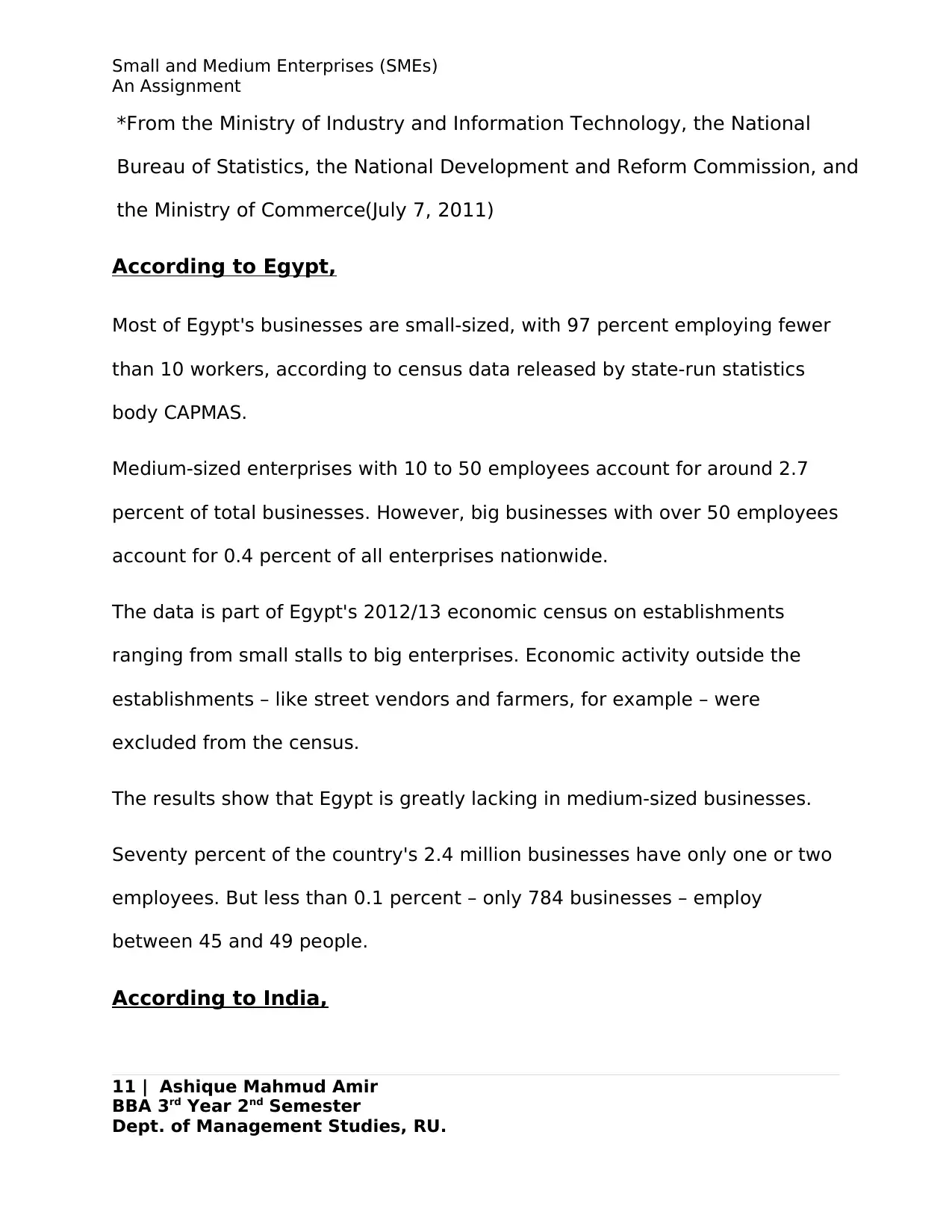
Small and Medium Enterprises (SMEs)
An Assignment
*From the Ministry of Industry and Information Technology, the National
Bureau of Statistics, the National Development and Reform Commission, and
the Ministry of Commerce(July 7, 2011)
According to Egypt,
Most of Egypt's businesses are small-sized, with 97 percent employing fewer
than 10 workers, according to census data released by state-run statistics
body CAPMAS.
Medium-sized enterprises with 10 to 50 employees account for around 2.7
percent of total businesses. However, big businesses with over 50 employees
account for 0.4 percent of all enterprises nationwide.
The data is part of Egypt's 2012/13 economic census on establishments
ranging from small stalls to big enterprises. Economic activity outside the
establishments – like street vendors and farmers, for example – were
excluded from the census.
The results show that Egypt is greatly lacking in medium-sized businesses.
Seventy percent of the country's 2.4 million businesses have only one or two
employees. But less than 0.1 percent – only 784 businesses – employ
between 45 and 49 people.
According to India,
11 | Ashique Mahmud Amir
BBA 3rd Year 2nd Semester
Dept. of Management Studies, RU.
An Assignment
*From the Ministry of Industry and Information Technology, the National
Bureau of Statistics, the National Development and Reform Commission, and
the Ministry of Commerce(July 7, 2011)
According to Egypt,
Most of Egypt's businesses are small-sized, with 97 percent employing fewer
than 10 workers, according to census data released by state-run statistics
body CAPMAS.
Medium-sized enterprises with 10 to 50 employees account for around 2.7
percent of total businesses. However, big businesses with over 50 employees
account for 0.4 percent of all enterprises nationwide.
The data is part of Egypt's 2012/13 economic census on establishments
ranging from small stalls to big enterprises. Economic activity outside the
establishments – like street vendors and farmers, for example – were
excluded from the census.
The results show that Egypt is greatly lacking in medium-sized businesses.
Seventy percent of the country's 2.4 million businesses have only one or two
employees. But less than 0.1 percent – only 784 businesses – employ
between 45 and 49 people.
According to India,
11 | Ashique Mahmud Amir
BBA 3rd Year 2nd Semester
Dept. of Management Studies, RU.
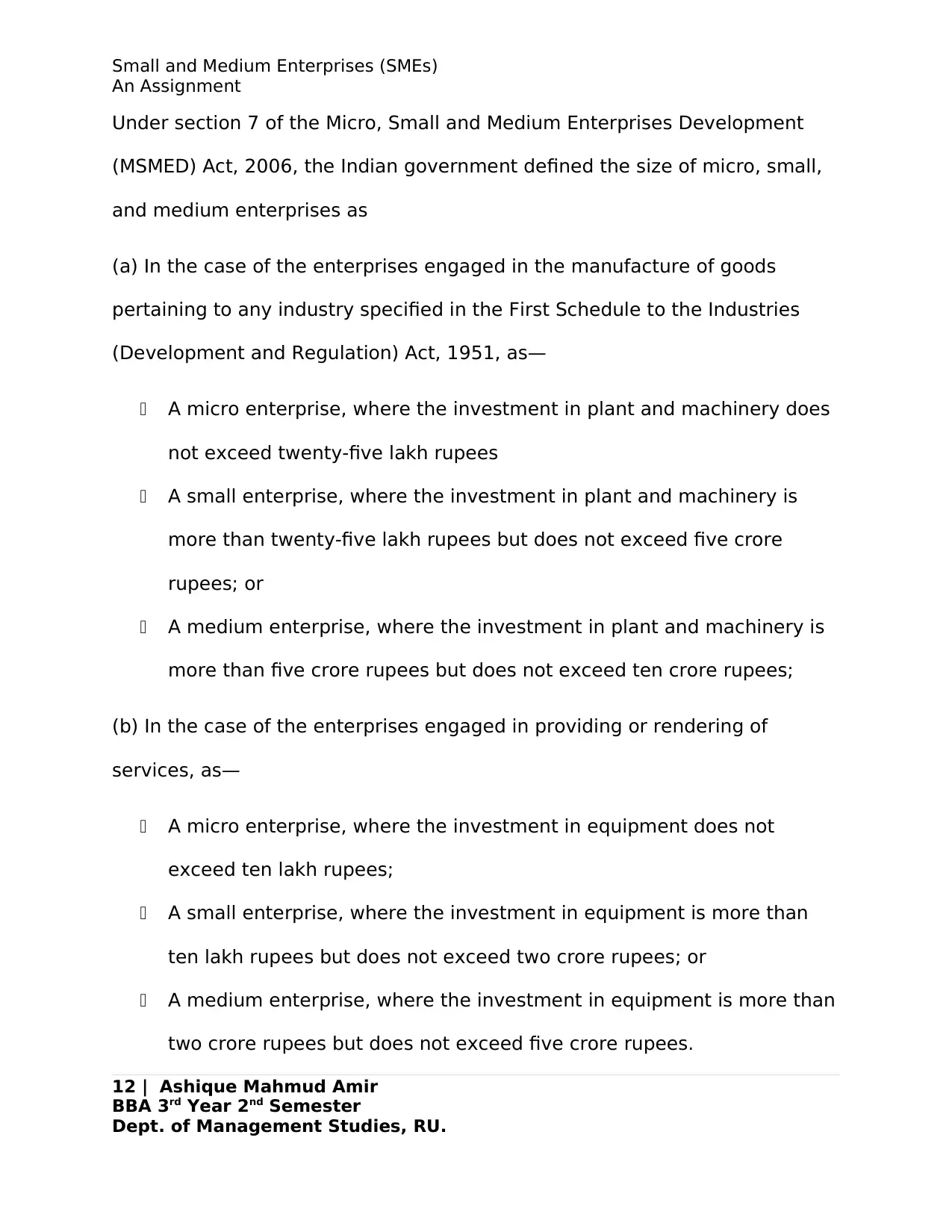
Small and Medium Enterprises (SMEs)
An Assignment
Under section 7 of the Micro, Small and Medium Enterprises Development
(MSMED) Act, 2006, the Indian government defined the size of micro, small,
and medium enterprises as
(a) In the case of the enterprises engaged in the manufacture of goods
pertaining to any industry specified in the First Schedule to the Industries
(Development and Regulation) Act, 1951, as—
A micro enterprise, where the investment in plant and machinery does
not exceed twenty-five lakh rupees
A small enterprise, where the investment in plant and machinery is
more than twenty-five lakh rupees but does not exceed five crore
rupees; or
A medium enterprise, where the investment in plant and machinery is
more than five crore rupees but does not exceed ten crore rupees;
(b) In the case of the enterprises engaged in providing or rendering of
services, as—
A micro enterprise, where the investment in equipment does not
exceed ten lakh rupees;
A small enterprise, where the investment in equipment is more than
ten lakh rupees but does not exceed two crore rupees; or
A medium enterprise, where the investment in equipment is more than
two crore rupees but does not exceed five crore rupees.
12 | Ashique Mahmud Amir
BBA 3rd Year 2nd Semester
Dept. of Management Studies, RU.
An Assignment
Under section 7 of the Micro, Small and Medium Enterprises Development
(MSMED) Act, 2006, the Indian government defined the size of micro, small,
and medium enterprises as
(a) In the case of the enterprises engaged in the manufacture of goods
pertaining to any industry specified in the First Schedule to the Industries
(Development and Regulation) Act, 1951, as—
A micro enterprise, where the investment in plant and machinery does
not exceed twenty-five lakh rupees
A small enterprise, where the investment in plant and machinery is
more than twenty-five lakh rupees but does not exceed five crore
rupees; or
A medium enterprise, where the investment in plant and machinery is
more than five crore rupees but does not exceed ten crore rupees;
(b) In the case of the enterprises engaged in providing or rendering of
services, as—
A micro enterprise, where the investment in equipment does not
exceed ten lakh rupees;
A small enterprise, where the investment in equipment is more than
ten lakh rupees but does not exceed two crore rupees; or
A medium enterprise, where the investment in equipment is more than
two crore rupees but does not exceed five crore rupees.
12 | Ashique Mahmud Amir
BBA 3rd Year 2nd Semester
Dept. of Management Studies, RU.
⊘ This is a preview!⊘
Do you want full access?
Subscribe today to unlock all pages.

Trusted by 1+ million students worldwide
1 out of 70
Related Documents
Your All-in-One AI-Powered Toolkit for Academic Success.
+13062052269
info@desklib.com
Available 24*7 on WhatsApp / Email
![[object Object]](/_next/static/media/star-bottom.7253800d.svg)
Unlock your academic potential
Copyright © 2020–2025 A2Z Services. All Rights Reserved. Developed and managed by ZUCOL.





